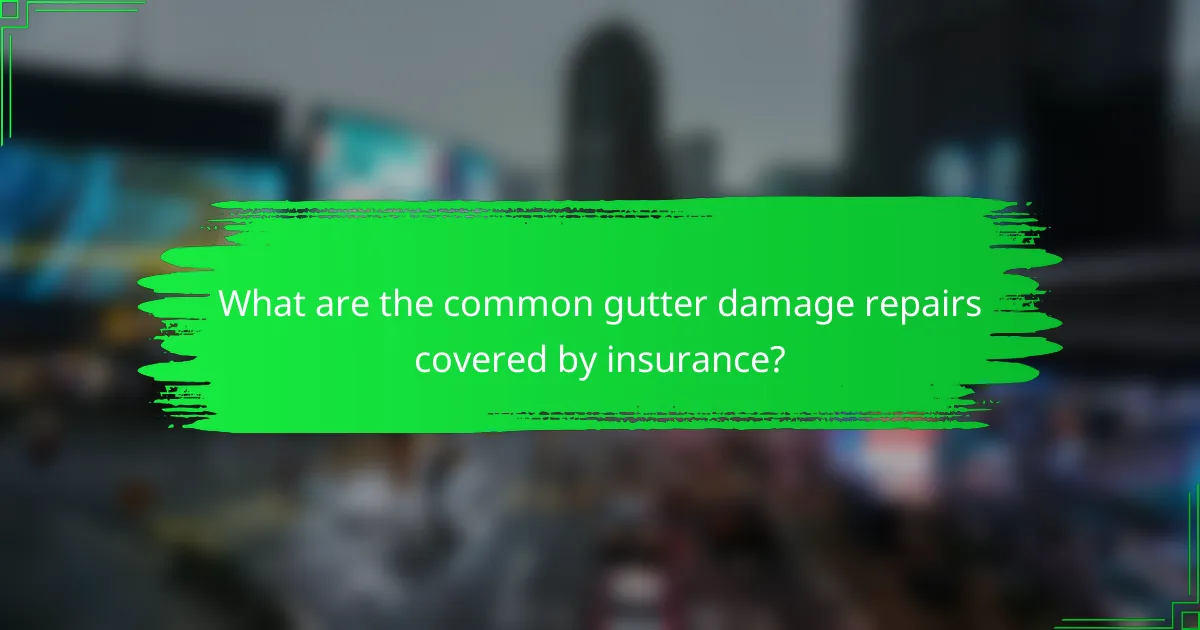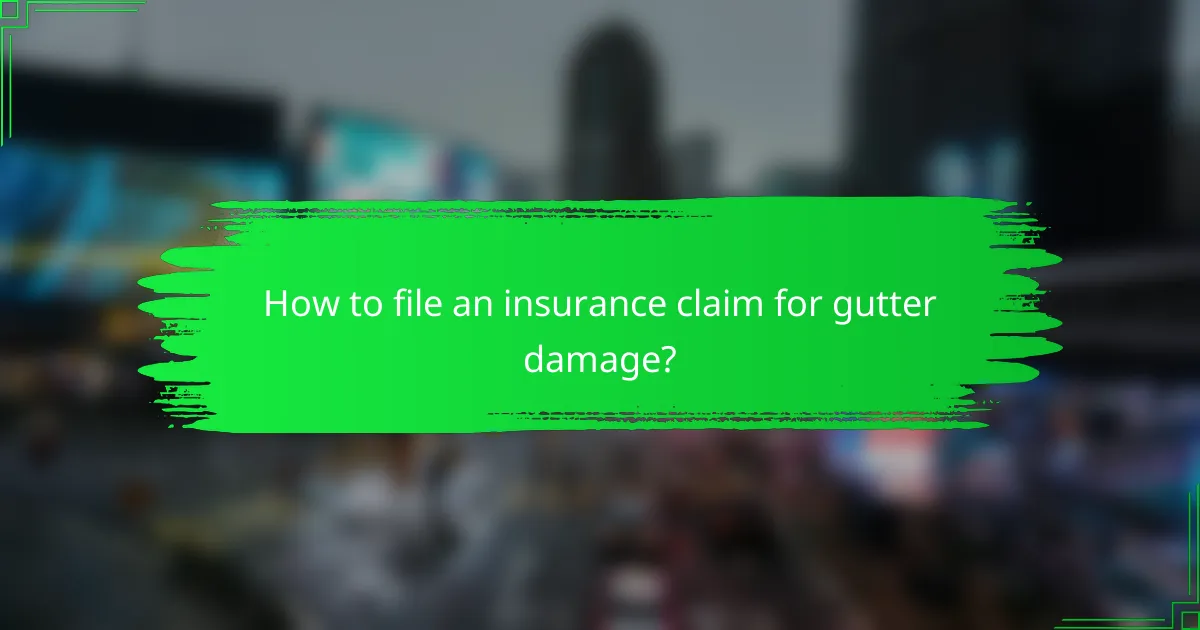When dealing with gutter damage, understanding your insurance coverage is crucial for effective repairs. Insurance typically covers various aspects of gutter maintenance and repair, but specifics can vary by policy. It’s important to assess the damage, document it, and communicate with your insurance provider to ensure you receive the necessary support for your claims process.

What are the common gutter damage repairs covered by insurance?
Insurance typically covers several common gutter damage repairs, including roof gutter replacement, cleaning and maintenance, leak and hole repairs, downspout repairs, and emergency water damage mitigation. Coverage can vary based on the policy, so reviewing the specifics of your insurance plan is essential.
Roof gutter replacement
Roof gutter replacement is often covered by insurance if the damage is due to a covered peril, such as severe weather or falling debris. Homeowners should document the damage and obtain estimates from licensed contractors to support their claims. It’s advisable to check your policy limits and any deductibles that may apply.
Replacement costs can vary widely, typically ranging from a few hundred to several thousand dollars, depending on the materials used and the extent of the damage. Common materials include aluminum, vinyl, and copper, each with different price points and durability.
Gutter cleaning and maintenance
Insurance usually does not cover routine gutter cleaning and maintenance, as these are considered homeowner responsibilities. However, if cleaning is necessary due to damage from a covered event, some policies may reimburse those costs. Regular maintenance can prevent more significant issues and should be prioritized.
Homeowners should aim to clean gutters at least twice a year, especially in regions with heavy foliage. This proactive approach can save money in the long run by avoiding costly repairs from clogs or overflow damage.
Repairing leaks and holes
Repairing leaks and holes in gutters is generally covered by insurance if the damage is caused by a covered event. Homeowners should document the leaks with photos and obtain repair estimates to facilitate the claims process. Timely repairs can prevent water damage to the home’s foundation and landscaping.
Common methods for repairing leaks include using sealants or replacing damaged sections. Costs for these repairs can range from $100 to $500, depending on the severity of the damage and the materials needed.
Downspout repairs
Downspout repairs are often included in gutter damage coverage if the repairs are necessitated by a covered peril. Homeowners should ensure that any damage is well-documented and that they understand their policy’s specific terms regarding downspout repairs.
Repairing or replacing downspouts can cost between $100 and $300, depending on the complexity of the repair and the materials used. Properly functioning downspouts are crucial for directing water away from the home and preventing flooding.
Emergency water damage mitigation
Emergency water damage mitigation is typically covered by insurance if it results from gutter failure due to a covered event. This may include costs for water extraction, drying, and repairs to affected areas of the home. Quick action is essential to minimize damage and support a successful claim.
Homeowners should contact their insurance provider immediately after an incident and document all damage and mitigation efforts. Costs for emergency services can vary widely, often ranging from a few hundred to several thousand dollars, depending on the extent of the damage and the services required.

How to file an insurance claim for gutter damage?
Filing an insurance claim for gutter damage involves several key steps to ensure you receive the coverage you need. Start by assessing the damage, documenting it thoroughly, and contacting your insurance provider to initiate the claims process.
Documenting the damage
Begin by taking clear photographs of the damaged gutters from various angles. Include close-ups of any significant issues, such as holes or detachment, and wide shots that show the overall condition of your home’s exterior.
Make a list of any related damages, such as water damage to the foundation or siding, as this can impact your claim. Keep records of the date the damage occurred and any weather events that may have contributed.
Contacting your insurance provider
Reach out to your insurance provider as soon as possible to report the damage. Use the customer service number provided on your policy documents or their website for quick access.
Be prepared to provide details about the damage, including when it occurred and any documentation you have gathered. This initial contact will help set the tone for your claim process.
Submitting required forms
Your insurance company will likely require you to complete specific forms to process your claim. These forms may include a claim report and a damage assessment form.
Ensure that all information is accurate and complete to avoid delays. If you’re unsure about any section, ask your insurance representative for clarification before submitting.
Following up on the claim status
After submitting your claim, follow up regularly to check its status. Most insurance companies provide a timeline for processing claims, but it’s wise to stay proactive.
If you haven’t heard back within the expected timeframe, contact your provider to inquire about any updates. Keeping communication open can help expedite the resolution of your claim.

What factors affect insurance coverage for gutter repairs?
Several factors influence insurance coverage for gutter repairs, including the type of insurance policy, the extent of the damage, the age of the gutters, and their maintenance history. Understanding these elements can help homeowners navigate their insurance claims more effectively.
Type of insurance policy
The type of insurance policy you have plays a crucial role in determining coverage for gutter repairs. Homeowners insurance typically covers sudden and accidental damages, but may exclude wear and tear or maintenance-related issues. It’s essential to review your policy details to understand what is included and any specific exclusions that may apply.
For instance, if your policy is a named-peril policy, it will only cover damages caused by specific events listed in the policy, whereas an open-peril policy may offer broader coverage. Always consult with your insurance agent to clarify your policy’s terms.
Extent of the damage
The extent of the damage to your gutters significantly impacts insurance coverage. Minor repairs may be covered under your policy, while extensive damage may require a different approach. Insurers often assess whether the damage was sudden or gradual to determine eligibility for a claim.
For example, if a storm causes immediate damage to your gutters, you are more likely to receive coverage than if the gutters have been leaking for months due to neglect. Documenting the damage with photos can support your claim process.
Age of the gutters
The age of your gutters can affect how your insurance company views your claim. Older gutters may be considered more susceptible to damage and less likely to be covered if they fail due to age-related issues. Insurers may argue that homeowners should have replaced aging systems to prevent such damage.
Generally, gutters that are more than 20 years old may face scrutiny during the claims process. Regular inspections and timely replacements can help mitigate issues related to age.
Maintenance history
Your gutters’ maintenance history is a critical factor in insurance coverage. Insurers often look for evidence of regular upkeep, such as cleaning and repairs, to determine if the damage is due to neglect. A lack of maintenance can lead to denied claims.
To ensure coverage, keep records of all maintenance activities, including receipts for cleaning services or repairs. This documentation can demonstrate that you have taken reasonable steps to maintain your gutters and may strengthen your claim if damage occurs.

What are the costs associated with gutter damage repairs?
The costs associated with gutter damage repairs can vary significantly based on the extent of the damage and the type of repairs needed. Homeowners should expect to spend anywhere from a few hundred to several thousand dollars, depending on factors such as repair complexity and materials used.
Average repair costs
On average, gutter repair costs typically range from $150 to $500 for minor issues like leaks or small dents. More extensive repairs, such as fixing sagging gutters or replacing sections, can cost between $500 and $1,500. It’s wise to obtain multiple quotes from contractors to ensure competitive pricing.
Cost of gutter replacement
Replacing gutters can be significantly more expensive than repairs, with costs generally ranging from $1,000 to $3,000 for an average-sized home. Factors such as the material chosen—aluminum, vinyl, or copper—can influence the total price. Homeowners should consider the long-term benefits of investing in higher-quality materials, which may offer better durability.
Factors influencing repair costs
Several factors can influence the overall cost of gutter repairs. The severity of the damage, the type of gutter system in place, and the accessibility of the gutters all play a role. For example, if gutters are located on a multi-story home, labor costs may increase due to the need for specialized equipment.
Additionally, local labor rates can vary widely, so it’s advisable to research average costs in your area. Homeowners should also consider seasonal factors; repairs may be more expensive during peak seasons when demand for contractors is high.

What are the prerequisites for gutter damage insurance coverage?
To qualify for gutter damage insurance coverage, homeowners typically need to have a valid homeowner’s insurance policy that includes provisions for exterior damage. Additionally, the damage must be caused by a covered peril, such as storms or falling trees, and not due to neglect or lack of maintenance.
Policy terms and conditions
Understanding the specific terms and conditions of your homeowner’s insurance policy is crucial for gutter damage coverage. Policies often outline what types of damage are included, such as storm damage, and may exclude wear and tear or damage from improper installation.
Homeowners should review their policy limits and deductibles, as these factors will affect out-of-pocket costs during a claim. For instance, if your policy has a deductible of $1,000, you will need to pay that amount before insurance coverage kicks in.
It’s advisable to document the condition of your gutters regularly and keep records of any maintenance performed. This documentation can support your claim by demonstrating that the damage was not due to neglect, which could lead to denial of coverage.
